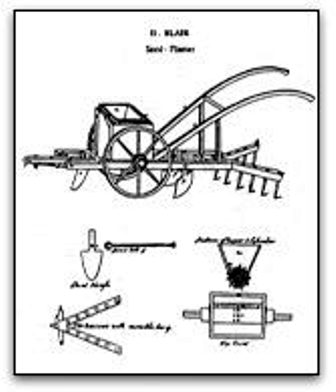Experts in Medicine
There is a well-documented trend of growth among black or African American female medical school graduates. Since 1986, the proportion of female graduates has increased 53%, and the proportion of male graduates has declined 39%.

Henry Blair was the second African American to receive a patent on his invention. Blair, who was born in 1807, received his first patent on October 14, 1834 for his invention of the corn seed planter. It allowed the farmers to plant their corn much faster, and with much less labor. The machine also helped with weed control.
Little is known of the life of Henry Blair, except that he was probably a free farmer of Montgomery County, Maryland. it is assumed he was a free man since the patent would not have been approved to be in the name of a slave. Only the second African American to receive a patent, he was a forerunner of a long line of future black inventors. His invention, a corn-planting machine, was able to seed corn in a checkerboard fashion, a system which provided good weed control.
Henry Blair was the only inventor to be identified in the Patent Office records as "a colored man." Uneducated, and unable to read or write, Henry Blair had a gift for invention and did not allow his race, lack of education or other negative factors of the time hold him back. Signing his name on Patent No. X8447 with a simple X, Henry Blair helped improve farming and the livelihood of farmers.
An article from The Mechanics' Magazine in 1836 carried a story of Henry Blair's invention and stated: "A free man of colour, Henry Blair by name, has invented a machine called the corn-planter, which is now exhibiting in the capital of Washington. It is described as a very simple and ingenious machine, which, as moved by a horse, opens the furrow, drops (at proper intervals, and in an exact and suitable quantity,) the corn, covers it, and levels the earth, so as, in fact, to plant the corn as rapidly as a horse can draw a plough over the ground. The inventor thinks it will save the labor of eight men. He is about to make some alterations in it to adapt it to the planting of cotton."
Two years later, he designed a similar device suitable for planting cotton. The operation of the newly patented cotton planter was as follows:
Operation: When the horses draw the machine, the right, and left half shovels or bar shares (as the planter may choose) throws a ridge—the tongue plow makes the drill, the cylinder is revolving with the wheels, catches the seed in the holes made on its periphery as they pass through the hopper, and lets them drop into the drill, and the press cover closes the sides of the drill so as to cover the seed.
Henry Blair died in 1860 of unknown causes. For a long time Blair was thought to be the first African American to receive a patent, and is still confused today as being the first. It was later found out that actually Thomas Jennings received a patent for his invention of the dry cleaning process in 1821.
Don't miss a single page. Find everything you need on our complete sitemap directory.
Listen or read the top speeches from African Americans. Read more
Read about the great African Americans who fought in wars. Read more
African Americans invented many of the things we use today. Read more
Thin jazz, think art, think of great actors and find them here. Read more
Follow the history of Black Americans from slave ships to the presidency. Read more
Olympic winners, MVPS of every sport, and people who broke the color barrier. Read more
These men and women risked and sometimes lost their life to fight for the cause. Read more
Meet the people who worked to change the system from the inside. Read more

Visit my RedBubble page and use Michael Arnold Art to create greeting cards, T-shirts, mugs, and more.

The variety and impressive numbers of mammals, birds and marine wildlife in Alaska draw visitors from all over the world. For some travelers, Alaska is wilderness, at least compared to what they may know from back home. The pristine wilderness of Alaska is, perhaps, the last vestige of thriving populations of North American wildlife. Where else can you see polar bears, bald eagles, blue and humpbacked whales, gray wolves, grizzly bears, orcas, lynx, moose, and hundreds of other rare and endangered species in their original and undisturbed natural habitats?

Enjoy our website filled with original signed acrylic paintings by award winning Artist Michael Arnold. Located in Citrus County Florida, Michael Arnold is a the editor at the Citrus County Chronicle. When he's not busy being an editor, he is an avid artist who enjoys painting in a variety of styles. We hope you take the time to click on each image to see a larger view and to learn what the artist, Michael Arnold has to say about his paintings.

As dog owners and people who care deeply for animals and wildlife, we wanted our Dog Encyclopedia to be a website that could empower pet owners to create the most positive, loving environment for their dogs. Dog Encyclopedia realizes that owning a dog is like adding a new member to your family.

Floridian Nature has everything your are looking for in Florida nature. The wildlife of Florida is rich and varied, yet most of us are familiar with only a dozen or so species: the "well known endangered species such as manatees and panthers; those, like raccoons and squirrels, that have adapted to urban environments; the frightening alligators and black bears; and those like the armadillo who can't seem to cross the road. Yet they are just a few of the many animal species found in Florida.
